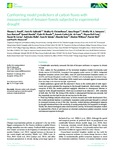Use este identificador para citar ou linkar para este item:
http://www.alice.cnptia.embrapa.br/alice/handle/doc/965567| Título: | Confronting model predictions of carbon fluxes with measurements of Amazon forests subjected to experimental drought. |
| Autoria: | POWELL, T. I.  GALBRAITH, D. R.   CHRISTOFFERSEN, B. O.   HARPER, A.   IMBUZEIRO, H. M. A.   ROWLAND, L.   ALMEIDA, S.   BRANDO, P. M.   COSTA, A. C. L. da   COSTA, M. H.   LEVINE, N. M.   MALHI, Y.   SALESKA, S. R.   SOTTA, E.   WILLIAMS, M.   MEIR, P.   MOORCROFT, P. R.   |
| Afiliação: | Thomas L. Powell, Department of Organismic and Evolutionary Biology, Harvard University, Cambridge, MA 02138, USA David R. Galbraith, School of Geography, University of Leeds, Leeds, LS2 9JT, UK Environmental Change Institute, School of Geography and the Environment, University of Oxford, Oxford, OX1 3QY, UK Bradley O. Christoffersen, Department of Ecology and Evolutionary Biology, University of Arizona, Tucson, AZ 85721, USA Anna Harper, College of Engineering, Mathematics, and Physical Science, University of Exeter, Exeter, EX4 4QF, UK Department of Atmospheric Science, Colorado State University, Fort Collins, CO 80523, USA Hewlley M. A. Imbuzeiro, Grupo de Pesquisas em Interação Atmosfera-Biosfera, Universidade Federal de Vicosa, Vicosa, CEP 36570-000, Minas Gerias, Brazil Lucy Rowland, School of GeoSciences, University of Edinburgh, Edinburgh, EH8 9XP, UK Samuel Almeida, Museu Paraense Emilio Goeldi, Belem, CEP 66077-530, Para, Brazil Paulo M. Brando, Instituto de Pesquisa Ambiental da Amazônia, CEP 71503-505, Brasilia, Distrito Federal, Brazil Antonio Carlos Lola da Costa, Centro de Geociências, Universidade Federal do Para, Belem, CEP 66017-970, Para, Brazil Marcos Heil Costa, Grupo de Pesquisas em Interac~ao Atmosfera-Biosfera, Universidade Federal de Vicosa, Vicosa, CEP 36570-000, Minas Gerias, Brazil Naomi M. Levine, Department of Organismic and Evolutionary Biology, Harvard University, Cambridge, MA 02138, USA Yadvinder Malhi, Environmental Change Institute, School of Geography and the Environment, University of Oxford, Oxford, OX1 3QY, UK Scott R. Saleska, Department of Ecology and Evolutionary Biology, University of Arizona, Tucson, AZ 85721, USA ELENEIDE DOFF SOTTA, CPAF-AP Mathew Williams, School of GeoSciences, University of Edinburgh, Edinburgh, EH8 9XP, UK Patrick Meir, School of GeoSciences, University of Edinburgh, Edinburgh, EH8 9XP, UK Paul R. Moorcroft, Department of Organismic and Evolutionary Biology, Harvard University, Cambridge, MA 02138, USA. |
| Ano de publicação: | 2013 |
| Referência: | New Phytologist, Cambridge, Jul. 2013. |
| Conteúdo: | Considerable uncertainty surrounds the fate of Amazon rainforests in response to climate change. Here, carbon (C) flux predictions of five terrestrial biosphere models (Community Land Model version 3.5 (CLM3.5), Ecosystem Demography model version 2.1 (ED2), Integrated BIosphere Simulator version 2.6.4 (IBIS), Joint UK Land Environment Simulator version 2.1 (JULES) and Simple Biosphere model version 3 (SiB3)) and a hydrodynamic terrestrial ecosystem model (the Soil?Plant?Atmosphere (SPA) model) were evaluated against measurements from two large-scale Amazon drought experiments. Model predictions agreed with the observed C fluxes in the control plots of both experiments, but poorly replicated the responses to the drought treatments. Most notably, with the exception of ED2, the models predicted negligible reductions in aboveground biomass in response to the drought treatments, which was in contrast to an observed c. 20% reduction at both sites. For ED2, the timing of the decline in aboveground biomass was accurate, but the magnitude was too high for one site and too low for the other. Three key findings indicate critical areas for future research and model development. First, the models predicted declines in autotrophic respiration under prolonged drought in contrast to measured increases at one of the sites. Secondly, models lacking a phenological response to drought introduced bias in the sensitivity of canopy productivity and respiration to drought. Thirdly, the phenomenological water-stress functions used by the terrestrial biosphere models to represent the effects of soil moisture on stomatal conductance yielded unrealistic diurnal and seasonal responses to drought. |
| Thesagro: | Floresta tropical |
| NAL Thesaurus: | carbon cycle |
| Palavras-chave: | Tropical rainforest Ciclo do cabono Modelo de biosfera terrestre Terrestrial biosphere model |
| Tipo do material: | Artigo de periódico |
| Acesso: | openAccess |
| Aparece nas coleções: | Artigo em periódico indexado (CPAF-AP)  |
Arquivos associados a este item:
| Arquivo | Descrição | Tamanho | Formato | |
|---|---|---|---|---|
| CPAFAP2013Confrontingmodelpredictionsofcarbon.pdf | 2.18 MB | Adobe PDF |  Visualizar/Abrir |









